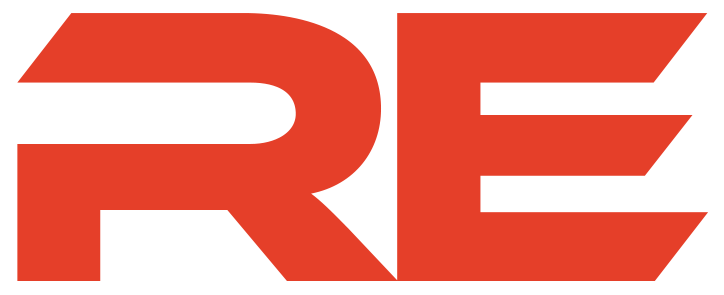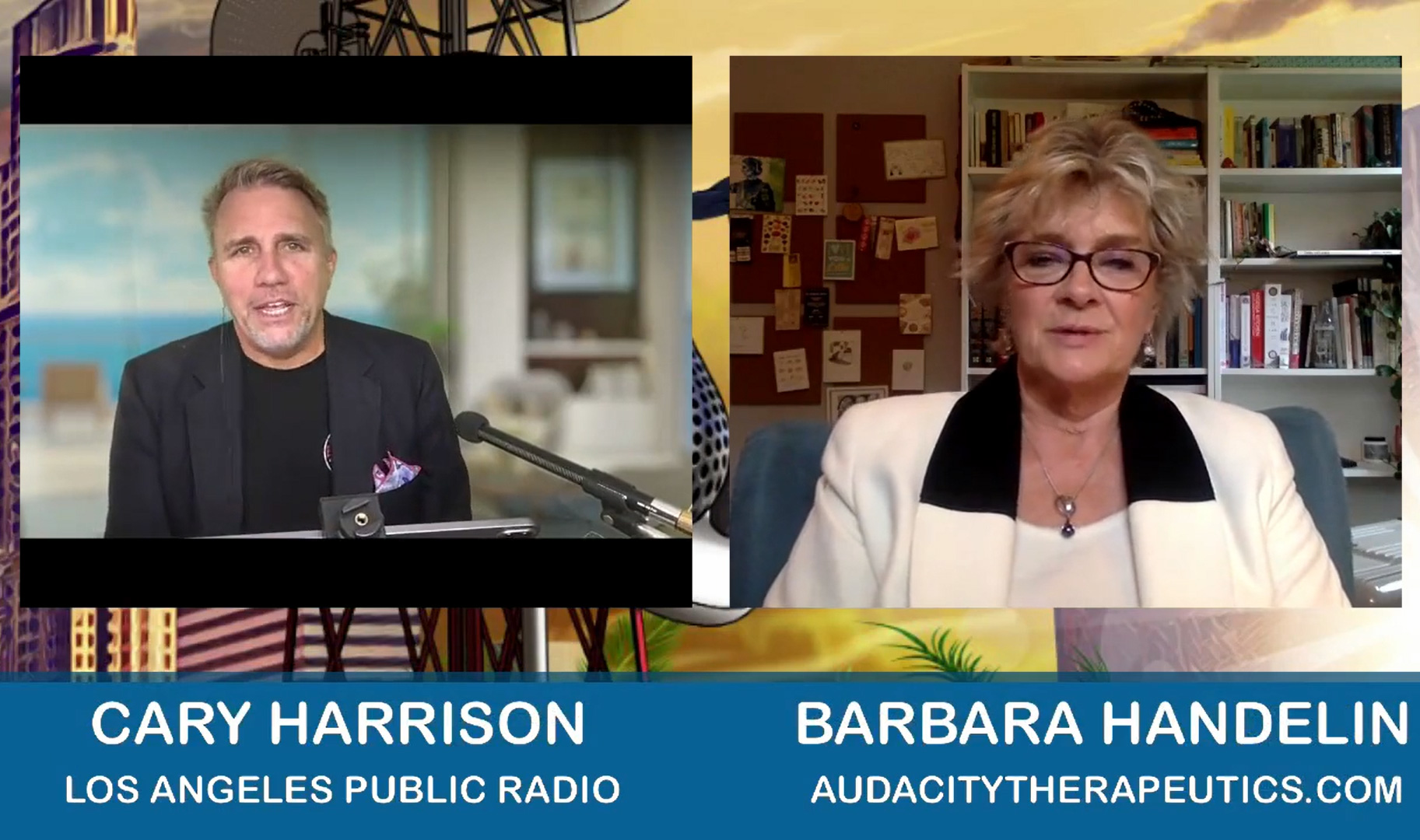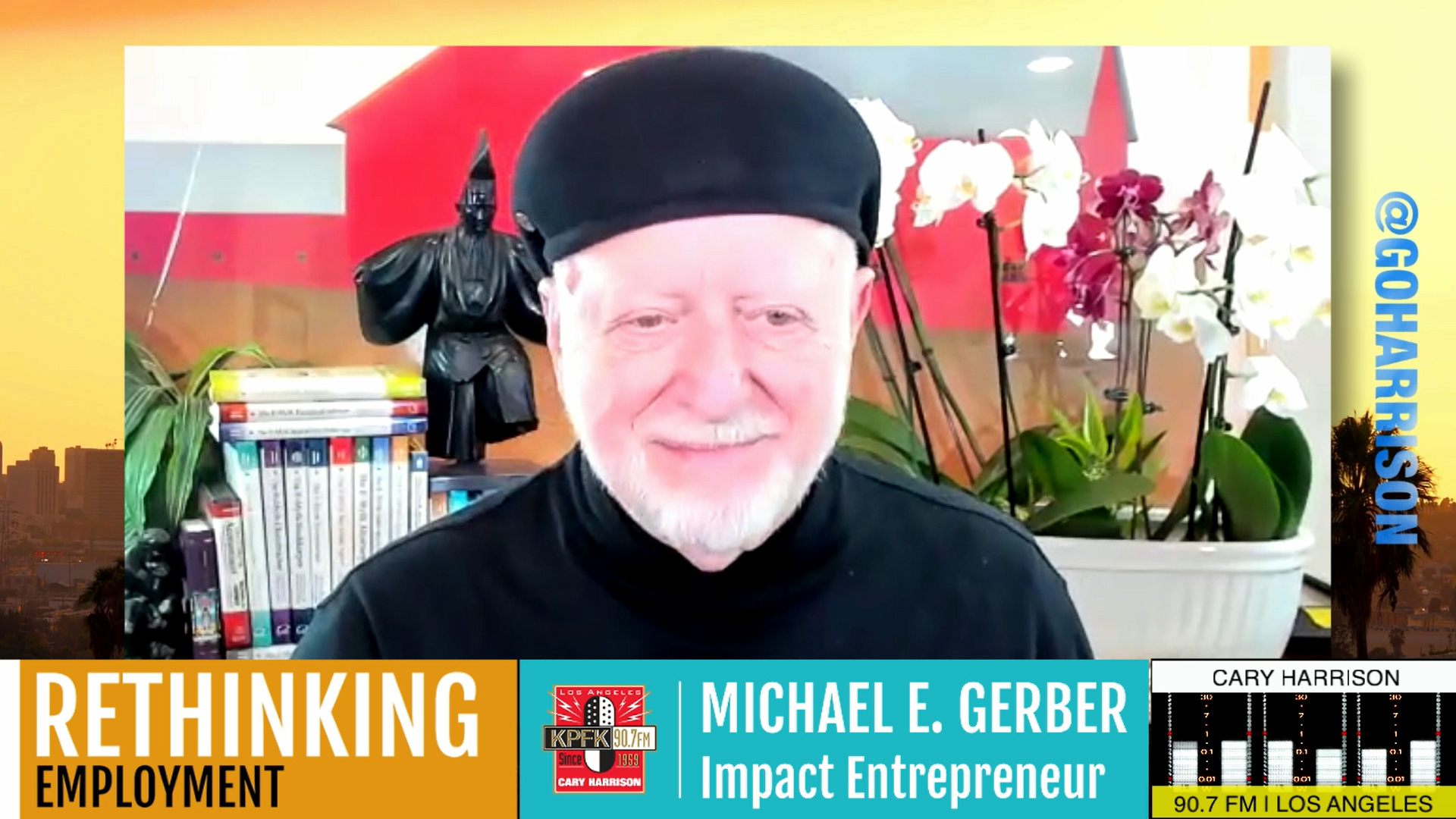Articles tagged with: interview
Can We Find More Effective Treatments for Autism, MS, & PTSD?
In a world where medication costs are skyrocketing and pharmaceutical companies search out ever-higher profit, KPFK’s Cary Harrison interviews Barbara Handelin Ph.D. of Audacity Therapeutics. Barbara talks about how repurposing existing medications can bring down costs while treating a broader range of illnesses with possibly greater therapeutic effect. You can get in touch with Audacity Therapeutics by calling 888-440-2520.
Transcript
Cary Harrison here with you. And I want to welcome you to this special program because today we're going to talk about a solution to a series of issues that plague pretty much everybody, you know, has one of these or the other, whether it's autism, whether it's PTSD, whether it's Alzheimer's disease and people feel hopeless, they feel limited.
They're not sure where to go. And medically speaking, you know, there's cures on the horizon. There's a lot being done, but did you know that existing pharmaceutical medicines, existing ones could be repurposed to actually attack these very conditions and many, many others. But unfortunately, the industry, as we all know, is not poised to allow that yet.
There are some brilliant scientists out there who have found a new pathway. One of them is Barbara Handelin. She's with us today. And Barbara, you are what we would call a superhero because what you're doing is bringing to the fore, the possibility that we can have existing medications, we don't have to invent brand new ones, but we could repurpose them to actually change the course of medicine.
Barbara Handelin: Yes, that's right. But as you said in your introduction, that's not happening. And it will never happen until, and unless we change how we incentivize our industry and we all know that whatever we incentivize is the behavior that we get. And right now our biotech and pharmaceutical industries are heavily incentivized to maximize profits, as opposed to maximizing the number of diseases that we can be treating and at what cost.
Barbara Handelin, about 75,000 children are going to be born in the next four years or so, we're going to find out that their brains are developing into an autistic profile. Uh, this is horrifying for the amount of people that are born in the United States and around the world with so far limited possibilities.
Tell us a little bit about what your plan is to change the nature of medicine.
Barbara Handelin: Well, we have, uh, an interest and an opportunity, uh, to stand up a young company that has been diligently working on trying to understand what autism actually is, you know, very today when we just diagnosed with them by behavioral patterns.
Barbara Handelin: And those are hard to pick up on until a child is, you know, 3, 4, 5, 6, 7, 8 years role as speech and various more normative social behaviors, um, start to fall away. So this company took the attitude of maybe we could understand what the actual underlying biochemistry of autism is. And if we could, then we'd be able to take a blood sample or urine sample.
Barbara Handelin: And instead of guessing, based on behavior, you could make a diagnosis and you could do that really early. While that child's brain is going through its major developmental processes, and you would have an opportunity to intervene using even the behavioral, uh, methods that are being used today, which we know are effective, especially the earlier we start.
Barbara Handelin: So this has been a lot of science and technology to figure all that out. The company actually poised to bring this to paper.
So I'm guessing there is a price tag to this. We hear from the pharmaceutical companies that the whole reason they can't actually really help us is that it's impossibly expensive, the research and development, um, the yacht payments, whatever it might be.
Barbara Handelin: Um, the fact that, you know, the industry spends at least 50 cents of every dollar in sales and marketing, but you know, we're, none of us are standing around at the pharmacy saying, oh, I, I don't know. Do I want this right? This brand or that product? No. You know, in sales and marketing, they teach you, you need to get the prospective customer to the point where they feel they must have your product.
Barbara Handelin: Well, we walk in, must have it.
I have a friend, Barbara, in Switzerland who works for Novartis and they make Claritin. And I said, well, you know, if this were the US, we would simply fly a crop duster and put in all kinds of allergens in the welfare crop dusting and give everyone hideous hay fever for a thousand square miles and then run Claritin ads.
And he said, that's brilliant. I said, no, I'm not, I'm not recommending it, but that's how we do it in the states. He goes, I don't think that's legal here. I said, good.
But to your point 50% goes to sales and marketing. It's like, it's like having an insurance company, you know, a third entity in that doctor, patient insurance company. Like what are they doing here? Well, they're taking their cut. Yes.
Barbara Handelin: Yeah, no it's um, so, uh, the, the numbers, you know, the numbers say yards about why we are aware we are.
But you've found a new way around this through a public benefits company where the public benefits, Hey, wow.
Um, but you have to raise money for it.
Barbara Handelin: Yeah, yeah. That's right. That's right. And the existing investor base for all things, medical, uh, is very expensive. Capital comes from starting with venture capitalists who are in the business of returning very, very exciting returns to their investors. So we need to be free as a company like ours.
Barbara Handelin: We need to be free to say notes and thanks to that kind of capital, because we want to work on medicines and diagnostics that are going to give us good margins but that are not going to produce the kind of outsized profits that are required, um, for investors, including wall street.
The three biggies that you're looking at right now are PTSD that would cover virtually every single military person who has returned from Iraq, from Afghanistan, from any other, uh, battlefield of conflict.
Going back to the Vietnam war, going back to world war II, the Korean war and wars regrettably, yet to come, they come back with severe PTSD. Uh, they're incapable of often carrying on even basic tasks. There they have difficulties having social skill sets, um, romantic capabilities anymore. And it's such a horrific and crippling disease, PTSD invisible as it is for you to be able to offer real solutions to that helps at least 10% of America right off the bat.
Autism helps at least 10 to 20% of America right off the bat. Multiple sclerosis helps again, a huge number of Americans right off the bat. What does it cost for you to put on one of these clinical trials so that we get an understanding of what investors might be looking at?
Barbara Handelin: Well, um, the cost for us to engage in clinical trials for any of those and the myriad of other, um, diseases disorders that we are looking to address with existing medicines are costs for significantly less than what we will hear in the general industry.
Barbara Handelin: And that's because we are extracting and capitalizing on the fact that these medicines have been trialed. Some of them have actually been used and prescribed in general practice. They may even have gone all the way to being a generic drug. So we know their thing, um, or we know what their limitations are.
Barbara Handelin: And now we are simply saying, let's use that same drug compound. We've invested a lot. Somebody invested a lot of money previously. Let's use that same thing and try it in a new indication. For new important indications.
So I'm going to make an analogy one that's popular, at least with the menfolk Viagra. Well, happy Viagra.
Viagra is now generic. You can get it on TV. You can get it in magazines. You can get it from the doctor of your choice. You don't have to explain, you can just get it. And that's because it's generic and you can get it for cheap. And we know it works. We know it's safe. We know how it works. Everything is already all figured out.
So you're taking something, for example, like a Viagra, which everyone understands, which is universally accepted and you're saying, but you know, it also does something else. It also helps lower blood pressure. I think it actually does. Um, and some others. Okay. Okay. And so we're going to actually focus it on lowering blood pressure and we're going to do it at a 10th of the price as it would ordinarily be.
Well, that's a big win for people with high blood pressure, like most Americans. Um, that would just be a made up example, but that's what you're looking to do for your big three right now, multiple sclerosis (MS), Autism and PTSD. It’s finding ways like this, where you can make major changes at affordable prices.
Barbara Handelin: Correct. So for example, multiple sclerosis, uh, members of the audacity team have developed evidence that an old AIDS drug, an old anti-HIV drug can be extremely effective in treating multiple sclerosis. And you know, why do we care about that? Jeez, there's 60 other medications that are on the market right now for multiple sclerosis.
Barbara Handelin: But if you talk to people who have multiple sclerosis, most of them will tell you my disease is inadequately treated. I keep progressing. And some of my symptoms, like my debilitating fatigue ruining my life and I'm getting worse. That's an enormous market for a number of companies. So do you think they have an interest in picking up an old generic AIDS drug and letting that come on the market as a potentially more effective treatment for multiple sclerosis?
Barbara Handelin: Certainly not. And the investor base who would be wanting to invest in some exciting new cure for multiple sclerosis, they say, well, you're not going to be able to make that kind of, that kind of profit on an old drug. So therefore that investment doesn't flow in. Cary, we need a new class of investors.
Interesting question here, new class of investors, they get a major bang on return.
Plus they get to help the human race of which they are members personally. Watch out of that part. I mean, it's got so much upside that it's absolutely crazy. Um, these investors get to participate in that and we get to repurpose drugs that most pharmaceutical companies could literally not give a darn about.
As far as they're concerned. There ain't no more profit. The patents have expired. See ya. You're sitting on a treasure trove of dynamite data and information that can repurpose these things into nothing less, than magical cures. On your staff, on your team, part of your collective, part of your collaborative, uh, organization is a woman who was instrumental in us, understanding TB, tuberculosis, and getting very close to that cure.
Barbara Handelin: Oh, that's a, it's a great example of, um, a medicine that will come and we will be treating tuberculosis around the world, but it has taken 25 years of slaving under always underfunded conditions to eek forward the scientific basis and then the clinical trials, which are happening outside the United States states, because we don't have a lot of TB here.
Barbara Handelin: It will come to, to be, but it could have come to be, at least a decade ago, had the sufficient amount of funding been made available. But that funding, Cary, has to come with an expectation of simply a more modest return. Think of it as I want to put part of my 401k into, um, bonds, and I'm going to make a nice return over a long period of time.
Barbara Handelin: I will let my money sit, it's going to get invested in all the medicines we actually need and I'll get a nice regular return.
And a Child Entrepreneur Will Lead Them
Michael E. Gerber of Gerber Enterprises, LRT’s Impact Business Hero, intends - at the age of 85 - to pour his fine old wine of hard-earned enterprise-building wisdom into new bottles. Very new bottles - the youth of this world.
Michael is famed for having introduced the “E Myth” (“E” stands for Entrepreneur) book to hopeful businessmen-would-be’s back in the 80’s to public acclaim. This book and many of its “E-Myth” ilk afterwards, along with the driving force of Michael Gerber, turned this work into a publishing and training empire which at its height was touching millions of readers worldwide, and tens of thousands of clients.
While enjoying a rather busy “retirement,” he took a look at what was happening in the world around him and its failings: COVID, social media, cellphone addiction and an attention span slightly longer than a nanosecond, a huge number of businesses failing and a lot of people rudderless.
It was time to cull through his life’s work to find those tools which could be applied to today’s more complex society, and step back onto the stage.
He concluded that at least one subset of our society could be salvaged – those from 14 to 18 years of age. (What’s that old saying – catch ‘em young and train ‘em right?) He decided to rethink his “Dreaming Room” concept and apply its success principles – how to become a successful entrepreneur – to address their hopes.
He decided to rethink his “Dreaming Room” concept and apply the success principles – how to become as successful entrepreneur – to address their hopes for a better existence than what they see around them today.
Gerber scoffs at the age difference as possibly standing in the way. “These kids were born in the image of God and imbued with the spirit of creation,” he says.
“This is not from a religious sense or ideology, but in the larger world of spirituality. That’s their core, and one from which anything can happen if the proper tools are available. Their imagination and inspiration will provide the driving force, along with my tools, to help them create a more significant life.”
An Africa Spark
The idea for this refocusing of an aspect of his lifelong work came from a husband and wife student team in South Africa. Marlen and Hendrik Bohn were taking instruction at Michael’s Radical U. This five-year entrepreneurial development school sparked a dream of theirs – to transform the world of disadvantaged African youth. When they brought this idea to Michael’s door – he opened it warmly.
A “Dreaming Room” for the ages of 14-18 and a prospective Radical U spanning a shorter time and for much less than the $495 a year paid by adults is in the works. Will it speak differently to kids who appear to speak and think in digits? “No,” says Gerber, “this is what they will hear.”
“Do you have a cellphone nearby? Then turn it off! Your Digital Universe will never provide you and the spirit within you the answers you want. You weren’t created to be another ‘meme’ or digit in some meta-world.
He continues, “With our mindset and methodology, you will find the answers to ‘Who am I,’ and ‘Where am I going?’ and, you will acquire the wisdom accrued in my almost 50 years of creating successful entrepreneurs to help you get what you and your soul deserves.”
Marlen and Hendrik Bohn couldn’t be more enthusiastic. “We can’t wait to see where this venture goes and how it will enable young people to create something meaningful for their lives that sustains them and impacts others.”
Those seeking more details about the construct and purpose of Radical U can head here.





